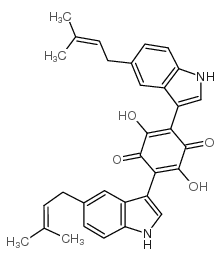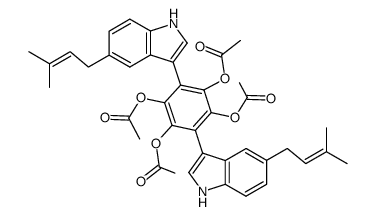CHEMICAL IDENTIFICATION
-
RTECS NUMBER :
-
DK3529000
-
CHEMICAL NAME :
-
p-Benzoquinone, 3,6-bis(5-(3-methyl-2-butenyl)indol-3-yl)-2,5-dihydro xy-
-
CAS REGISTRY NUMBER :
-
11051-88-0
-
BEILSTEIN REFERENCE NO. :
-
5188623
-
LAST UPDATED :
-
199612
-
DATA ITEMS CITED :
-
3
-
MOLECULAR FORMULA :
-
C32-H30-N2-O4
-
MOLECULAR WEIGHT :
-
506.64
-
WISWESSER LINE NOTATION :
-
T56 BMJ G1U1Y1&1 D- BL6V DVJ CQ FQ E- DT56 BMJ G1U1Y1&1
HEALTH HAZARD DATA
ACUTE TOXICITY DATA
-
TYPE OF TEST :
-
LD50 - Lethal dose, 50 percent kill
-
ROUTE OF EXPOSURE :
-
Oral
-
SPECIES OBSERVED :
-
Rodent - mouse
-
DOSE/DURATION :
-
221 mg/kg
-
TOXIC EFFECTS :
-
Details of toxic effects not reported other than lethal dose value
-
REFERENCE :
-
85GDA2 "CRC Handbook of Antibiotic Compounds," Vols.1- , Berdy, J., Boca Raton, FL, CRC Press, 1980- Volume(issue)/page/year: 3,310,1980
-
TYPE OF TEST :
-
LD50 - Lethal dose, 50 percent kill
-
ROUTE OF EXPOSURE :
-
Intraperitoneal
-
SPECIES OBSERVED :
-
Rodent - mouse
-
DOSE/DURATION :
-
41 mg/kg
-
TOXIC EFFECTS :
-
Details of toxic effects not reported other than lethal dose value
-
REFERENCE :
-
85GDA2 "CRC Handbook of Antibiotic Compounds," Vols.1- , Berdy, J., Boca Raton, FL, CRC Press, 1980- Volume(issue)/page/year: 3,310,1980
-
TYPE OF TEST :
-
LD50 - Lethal dose, 50 percent kill
-
ROUTE OF EXPOSURE :
-
Subcutaneous
-
SPECIES OBSERVED :
-
Rodent - mouse
-
DOSE/DURATION :
-
147 mg/kg
-
TOXIC EFFECTS :
-
Details of toxic effects not reported other than lethal dose value
-
REFERENCE :
-
85GDA2 "CRC Handbook of Antibiotic Compounds," Vols.1- , Berdy, J., Boca Raton, FL, CRC Press, 1980- Volume(issue)/page/year: 3,310,1980
|


